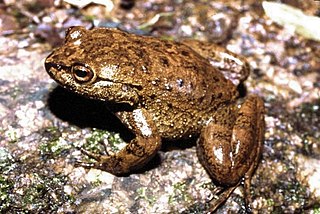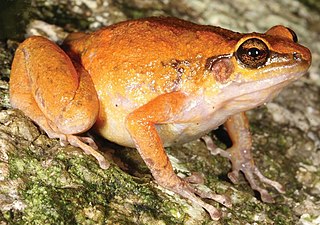Leptodactylodon stevarti is a species of frog in the family Arthroleptidae. It is known with certainty only from the area of its type locality, Monts de Cristal in northwestern Gabon. Only two specimens are known. However, there is an uncertain record from Equatorial Guinea that could represent this species or other, undescribed species. The specific name stevarti honours Tariq Stévart from the University of Brussels, an expert in western Central African orchids who help with the fieldwork. Common name Stévart's egg frog has been coined for the species.
Nyctimystes kubori is a species of frog in the family Pelodryadidae, also treated as the subfamily Pelodryadinae in the family Hylidae. It is endemic to Papua New Guinea and is widespread in the New Guinea Highlands between 141°E and 147°E and in the mountains of the Huon Peninsula. The specific name kubori refers to its type locality in the Kubor Mountains. Common name sandy big-eyed treefrog has been coined for this species.
Craugastor adamastus is a species of frog in the family Craugastoridae. It is endemic to Guatemala and only known from its type locality near Aldea Vista Hermosa, on the northern slopes of the eastern portion of the Sierra de las Minas, where the type series was collected in 1980–1981.
Cycloramphus dubius is a species of frog in the family Cycloramphidae. It is endemic to the state of São Paulo, Brazil. Common name São Paulo button frog has been coined for it.
Cycloramphus duseni is a species of frog in the family Cycloramphidae. It is endemic to southern Brazil and only known from its type series collected in 1911 from near Casa Ypiranga along the Curitiba–Paranaguá railway, in the Serra do Mar, Paraná state. Prior to naming of Cycloramphus izecksohni in 1983, it was confused with this species. The specific name duseni honors Per Dusén, Swedish naturalist who collected the type series. Common name Ypiranga button frog has been coined for this species.
Cycloramphus izecksohni is a species of frog in the family Cycloramphidae. It is endemic to southern Brazil and occurs in the Serra do Mar in the states of Santa Catarina, Paraná, and São Paulo. Prior to its description in 1983, it was confused with Cycloramphus duseni. Common name Izecksohn's button frog has been coined for this species.
Megaelosia jordanensis is a species of frog in the Hylodidae family. It is endemic to southeastern Brazil and only known from its type locality, Campos do Jordão in the São Paulo state. Its natural habitat is forest at 1,700 m (5,600 ft) asl.
Ischnocnema holti is a species of frog in the family Brachycephalidae. It is endemic to the state of Rio de Janeiro, Brazil, and is known from the Serra da Mantiqueira in Itatiaia and Serra dos Órgãos in Teresópolis. Common name Holt's robber frog has been coined for this species.
Holoaden bradei, or the Itatiaia highland frog, is a species of frog in the family Craugastoridae. It is endemic to the Itataia Mountains of southeastern Brazil. It is restricted to an area of 10km2 at an elevation of 2,400 to 2,600, the type locality being at 22°21′S, 44°44′W at a location known as Alto Itatiaia. H. bradei is found among stones, mulch, and terrestrial bromeliads, in which it breeds through direct development. H. bradei may already be extinct in the wild because it has not been recorded in the wild for several decades.

Megaelosia is a genus of frogs in the Hylodidae family. The genus is endemic to the Serra do Mar and Serra da Mantiqueira in southeastern Brazil. These frogs are sometimes known as the big-tooth frogs.
Megaelosia bocainensis is a species of frog in the family Hylodidae. It is endemic to Brazil and only known from its type locality in the Serra da Bocaina National Park, São Paulo state.

Megaelosia boticariana is a species of frog in the family Hylodidae. It is endemic to southeastern Brazil and only known from few specimens from its type locality, Parque Estadual do Itapetinga in Atibaia, São Paulo state.
Megaelosia goeldii is a species of frog in the family Hylodidae. It is endemic to Southeast Brazil and occurs in São Paulo and Rio de Janeiro states. It is named after Émil Goeldi, a Swiss zoologist who worked in Brazil.

Proceratophrys schirchi is a species of frog in the family Odontophrynidae. It is endemic to eastern Brazil and occurs in southeastern Bahia, Espírito Santo, northeastern Minas Gerais, and Rio de Janeiro states. The specific name schirchi honours Paulo F. Schirch, a Brazilian zoologist who collected the type series. Common names Santo smooth horned frog and Brazilian smooth horned frog can refer to this species, the latter specifically referring to Proceratophrys precrenulata that is now considered a junior synonym only.

Cophixalus zweifeli is a species of frog in the family Microhylidae. It is endemic to northern Queensland, Australia, and only known from the area of its type locality in the Cape Melville National Park. The species was named to honour American herpetologist Richard G. Zweifel. Common name Zweifel's frog has been coined for it. It is one of the five northeast Australian Cophixalus species that are specialized in boulder field habitats.

Blyth's river frog, Blyth's frog, giant Asian river frog, or (ambiguously) giant frog, Limnonectes blythii, is a species of frog in the Dicroglossidae family found from Myanmar through western Thailand and the Malay Peninsula to Sumatra and Borneo (Indonesia). Earlier records from Laos and Vietnam are considered misidentifications.
Meristogenys kinabaluensis is a species of frog in the family Ranidae. It is endemic to Borneo and is found in Sabah, Sarawak (Malaysia), and Kalimantan (Indonesia). The specific name refers to its type locality, Mount Kinabalu.
Quasipaa boulengeri is a species of frog in the Dicroglossidae family. It is known under many common names, including Boulenger's spiny frog, spiny-bellied frog, and Boulenger's paa frog. It is found in southern and southwestern China and northern Vietnam. It is a very common species that has declined. It is collected for human consumption, and it is also threatened by habitat loss. Its natural habitats are hill streams and ponds.
Nanorana medogensis is a species of frog in the Dicroglossidae family. It is endemic to Tibet, China, and only known from near its type locality in Mêdog County in south-eastern Tibet, near the Indian border. It lives in forested streams, and is sometimes also found at the edges of pools and ponds.
Odorrana andersonii is a species of frog in the family Ranidae that is found in northeastern India, upper Myanmar, southwestern China, northern Thailand, Laos, and Vietnam; records from Laos and Vietnam may refer to another species. They are found in low tree branches and on rocks along shaded rocky streams and large rivers with boulders, in evergreen forests and agricultural areas. Breeds takes place in streams.




